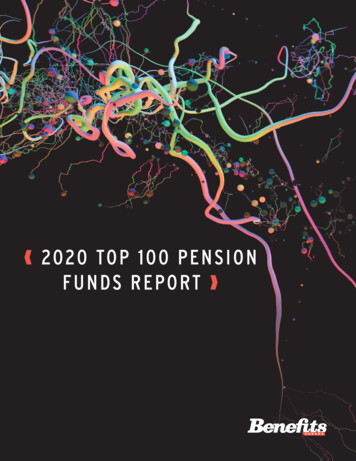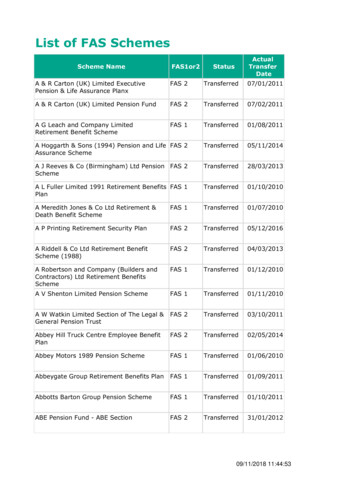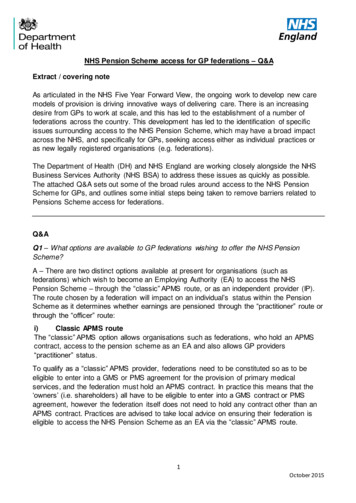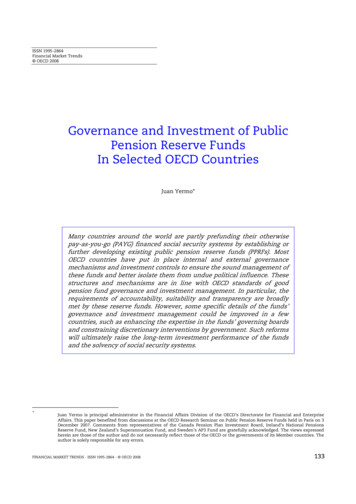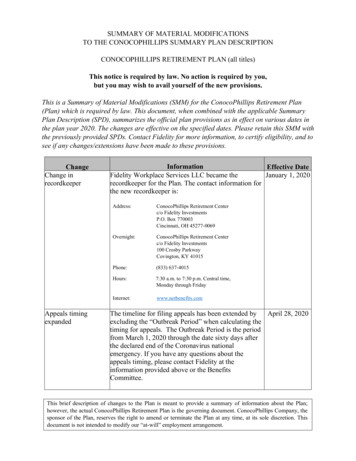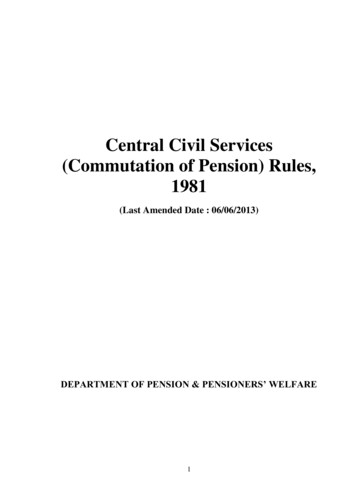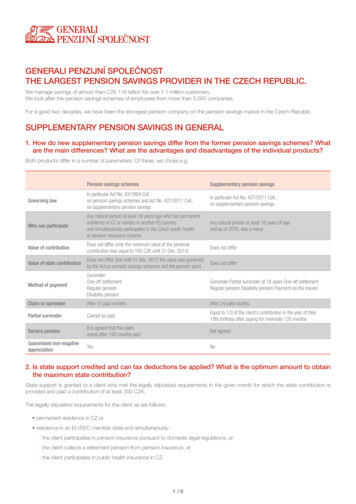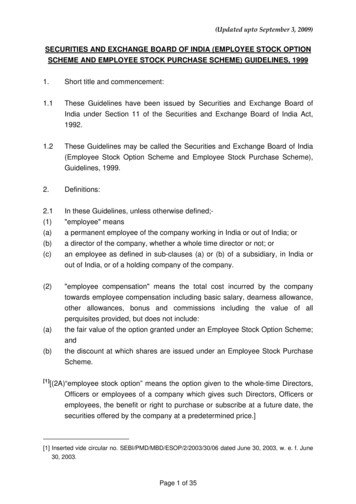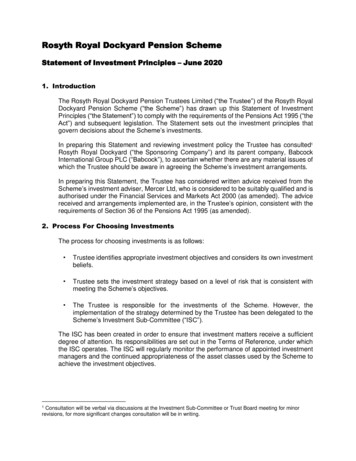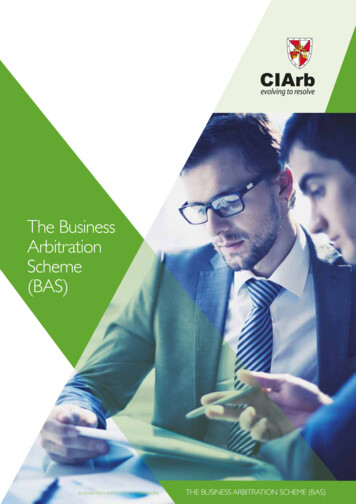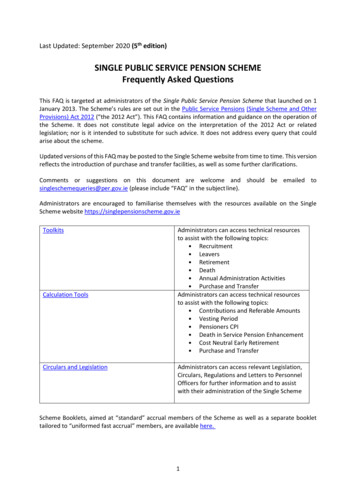
Transcription
Last Updated: September 2020 (5th edition)SINGLE PUBLIC SERVICE PENSION SCHEMEFrequently Asked QuestionsThis FAQ is targeted at administrators of the Single Public Service Pension Scheme that launched on 1January 2013. The Scheme’s rules are set out in the Public Service Pensions (Single Scheme and OtherProvisions) Act 2012 (“the 2012 Act”). This FAQ contains information and guidance on the operation ofthe Scheme. It does not constitute legal advice on the interpretation of the 2012 Act or relatedlegislation; nor is it intended to substitute for such advice. It does not address every query that couldarise about the scheme.Updated versions of this FAQ may be posted to the Single Scheme website from time to time. This versionreflects the introduction of purchase and transfer facilities, as well as some further clarifications.Comments or suggestions on this document are welcome and should be emailed tosingleschemequeries@per.gov.ie (please include “FAQ” in the subject line).Administrators are encouraged to familiarise themselves with the resources available on the SingleScheme website ion ToolsCirculars and LegislationAdministrators can access technical resourcesto assist with the following topics: Recruitment Leavers Retirement Death Annual Administration Activities Purchase and TransferAdministrators can access technical resourcesto assist with the following topics: Contributions and Referable Amounts Vesting Period Pensioners CPI Death in Service Pension Enhancement Cost Neutral Early Retirement Purchase and TransferAdministrators can access relevant Legislation,Circulars, Regulations and Letters to PersonnelOfficers for further information and to assistwith their administration of the Single SchemeScheme Booklets, aimed at “standard” accrual members of the Scheme as well as a separate booklettailored to “uniformed fast accrual” members, are available here.1
ContentsPART A – DESIGN AND MEMBERSHIP . 3PART B – VESTING . 7PART C – SINGLE SCHEME CONTRIBUTIONS AND RETIREMENT BENEFITS . 9PART D – MEDICAL GROUNDS RETIREMENT. 18PART E – DEPENDANT BENEFITS . 21PART F – PURCHASE AND TRANSFER . 23PART G -FAMILY LAW, PENSION ABATEMENT AND SIMULTANEOUS EMPLOYMENTS . 27PART H – RECRUITMENT, DEPARTURE AND ANNUAL PROCESSES . 29PART I – FURTHER INFORMATION . 31Appendix A — Single Scheme member contribution and accrual rates . 32Appendix B — Simultaneous Employments in the Single Scheme . 33Explanation of terms used in this documentAnnual Benefit StatementA statement issued prior to July annually to each Single Scheme member by their Relevant Authority. Itshows the money credits (“referable amounts”) towards pension and retirement lump sum accrued or“banked” by the member in the previous calendar year, and cumulatively in all years with that employer.It also shows how much money the member paid in Scheme contributions in the previous year.Normal Retirement AgeNormal Retirement Age is the age at which a Scheme member can retire and receive benefits under anoccupational pension scheme. For most members under the Single Scheme, the normal retirementage is the same as the age of eligibility for the State Pension (Contributory). At present this is 66 yearsof age.There are separate, lower Normal Retirement Ages in the Single Scheme for some fast-accrualmembers comprising Gardaí, Permanent Defence Force personnel, prison officers and full-timefirefighters.Pre-existing Public Service Pension SchemeAn occupational pension scheme in place in the public service prior to 1 January 2013.Referable AmountsThese are the money credits which Single Scheme members accrue or “bank”, on an ongoingcumulative basis throughout their careers, towards their eventual pension and retirement lump sumawards.Relevant AuthorityThis term means an individual public service body with responsibility for administering the SingleScheme for its staff who are members of the Scheme. In certain cases a member’s Relevant Authoritymay not be the employer, e.g. the Relevant Authority for primary school teachers is the Departmentof Education and Skills.2
PART A – DESIGN AND MEMBERSHIP1. What is the Single Public Service Pension Scheme (“Single Scheme”)?The Single Scheme is the occupational pension scheme for public servants hired since 2013. It is a definedbenefit scheme, with retirement benefits based on career-average pay (not final salary).Each Scheme member generates pension credits and retirement lump sum credits throughout theircareer. These money credits, called “referable amounts”, accrue as percentages of pay on an ongoingbasis. The referable amounts accrued each year are revalued annually until retirement in line withinflation (Consumer Price Index increases).The annual pension awarded on retirement is the cumulative total of a member’s pension referableamounts across all Relevant Authorities, and the retirement lump sum awarded is, similarly, the total ofthe member’s lump sum referable amounts across all Relevant Authorities.2. Who joins the Single Scheme?The Single Scheme applies to persons who start pensionable public service jobs on or after 1 January2013. The Single Scheme does not apply to pre-2013-hired public servants who are members of pre-existingpublic service pension schemes. Where such persons take approved extended leave (e.g. career breaks),then on resumption of workplace attendance, they remain members of their original public servicepension scheme.Similarly, seasonal pensionable public servants who reengage employment on the same contract ofemployment remain members of their original pension scheme A further exemption from Single Scheme membership applies in cases where a public servant previouslyheld membership of a pre-existing public service pension scheme and did not subsequently have a breakin service of more than 26 weeks as a public servant. This 26 week exemption is covered in more detailin questions 8 and 9 below.For further information please consult the Recruitment Toolkit.3. Is the Single Scheme registered with the Pensions Authority (formerly known as thePensions Board)?Yes. The Pensions Authority registration number is PB275744.4. Who determines if a role is a pensionable public service post?The 2012 Act requires that the role is declared to be a pensionable public service post in the conditionsof service or in the written offer of employment.Decisions about whether particular posts are pensionable is a matter for each Relevant Authority /employer, subject to the same considerations and approval processes that existed prior to the3
introduction of the Single Scheme (e.g. approval from parent Department / funding bodies).5. Is Single Scheme membership compulsory for qualifying persons?Yes. Section 10 of the 2012 Act provides that where a person is newly appointed to a pensionable publicservice post on or after 1 January 2013 they shall be entered into the Single Scheme, subject to the 26week exemption further detailed in question 8 and question 9.That being the legislated position, any person meeting those criteria and who is appointed to apensionable public service post must be entered into the Single Scheme, regardless of the duration oftheir contract or work pattern and irrespective of whether or not they have the capacity to havecompleted the Scheme Vesting period (see Part B).Persons appointed to ‘non-pensionable’ posts in the public service have no entitlement to membershipof (and should not be entered into) the Single Scheme.6. Is there a minimum age to be eligible to join the Single Scheme?Section 9(2)(b) of the 2012 Act stipulates the minimum Scheme membership eligibility age as 16 years.7. Is there a maximum age to be eligible to join the Single Scheme?The maximum compulsory retirement age in the Single Scheme is age 70. Accordingly, persons agedover 70 years of age cannot become members of the Single Scheme.8. How is the 26 week break in service measured for determining Scheme membershipeligibility?Single Scheme membership is the default pension position for new-hire pensionable public servants sincethe beginning of 2013. The most common exception to this is where, on or after 1 January 2013, apensionable public servant who is not a Single Scheme member ceases public service employment andsubsequently takes up a public service post no later than 26 weeks after ceasing the earlier employment.A ‘break in service’ in this context is measured as the gap between public service employments i.e. fromthe date of ceasing one public service employment to the date of commencement of a new public serviceemployment. For clarity, employment as a non-pensionable public servant should also be recognisedwhen determining if the 26 week exemptions applies.For example, a person ceases public service employment on 16 December 2018, having been a member of apre-existing public service pension scheme, that person subsequently takes up a further pensionable public service position on 17 June 2019, the break in service from 17 December 2018 to 16 June 2019 was 182 days, or exactly 26 weeks.4
that person would not be eligible to join the Single Scheme, having taken up a pensionable publicservice post no later than 26 weeks following cessation of the earlier public service employment.This person should be entered into the appropriate pre-existing pension scheme provided bytheir new employer.9. What previous employments should be considered when determining if an exemptionto Scheme membership applies under the 26 week break in service criteria?All previous employments with public service bodies should be considered in determining exemptionfrom Single Scheme membership for new employees.In general, public service bodies include all Relevant Authorities (a list of these is provided here).The Central Bank of Ireland is also to be considered a public service body for the purpose of the 26 weekbreak in service exemption.10. Can members of pre-existing public service pension schemes switch to the SingleScheme?No, members of pre-existing public service pension schemes cannot choose to join the Single Scheme.However, if a member of a pre-existing scheme ceases to be employed in the public service, and laterbecomes employed on a new contract as a pensionable public servant after a gap of more than 26 weeks,he or she will then become a Single Scheme member.11. Can someone be an active member of a pre-existing public service pension scheme andof the Single Scheme at the same time?No, it’s not possible to be an active member of a pre-existing public service pension scheme and of theSingle Scheme at the same time.However, it is possible for an active Single Scheme member to have preserved benefits from a preexisting scheme that accrued in an earlier career phase.12. How does inflation affect Single Scheme referable amounts and pensions?The Single Scheme provides for pension referable amounts and retirement lump sum referable amountsto be uprated in line with increases in the Consumer Price Index (CPI). Notification of the CPI as it appliesto Single Scheme referable amounts and pensions in payment will be communicated to RelevantAuthorities by way of an annual circular.Referable amounts accrued in a calendar year qualify for uprating at the end of the next calendar year.Single Scheme pensions in payment are also increased by reference to the CPI, however the timing ofthis increase is directed by the Minister for Public Expenditure and Reform.Any decreases in the CPI are not reflected in referable amounts or in pensions.5
Administrators are encouraged to review the “Leaving Single Scheme Employment and AnnualAdministration Activities” Training Resources which includes more detail on CPI and Single Schemereferable amounts.13. Who is responsible for paying Single Scheme benefits?Section 31(a) of the 2012 Act requires that the last employing Relevant Authority is responsible for payingall Scheme benefits associated with a Scheme member (including Scheme benefits accrued with otherRelevant Authorities). The benefits payable by the final Relevant Authority may include pension and lumpsum at retirement, death in service payments and surviving spouse / civil partner and children’s’pensions.14. How are Single Scheme benefits financed?The ultimate financing of Single Scheme benefit payments is dealt with in section 44(1)(b) of the 2012Act, which states that the payments will be met from funds provided by the Oireachtas.DPER does not operate any dedicated mechanism or arrangement to subvent or refund Single Schemebenefit payments made by Relevant Authorities, whether by direct money transfer to those RelevantAuthorities, indirect recoupment (to an oversight or funding authority / Department) or otherwise.In addition, other than the netting off of contribution refunds to leavers against overall employeecontributions remitted, Relevant Authorities are not allowed to recover the cost of such benefitpayments by withholding remittances of Single Scheme contributions.In that overall context, and having regard especially to the section 44(1)(b) provision, RelevantAuthorities, as part of their normal financial management and budget-setting activity, including annualengagement with the relevant funders (e.g. Government Departments, HSE), should factor Single Schemebenefit payment estimates into funding requests.For self-funding bodies, any issues arising in relation to Single Scheme benefit payment financing shouldbe raised with their parent Department.6
PART B – VESTING15. What is the Single Scheme vesting period?The vesting period is a time length of 24 months as a Scheme member which must pass before a personis eligible for full Scheme benefits. The period of 24 months of Scheme membership may be nonconsecutive, although any periods in respect of which a refund of contributions has been received willnot count towards vesting (unless the refunded contributions are subsequently repaid with applicablecompound interest (see question 21)).16. How is progress towards vesting measured for members on permanent or fixed-termtemporary contracts?For permanent staff, progress towards vesting is measured by simple elapse of time, and a member’sparticular work pattern (50%, 80%, 100%, etc.) is not relevant to completing the vesting period. Thismeans that, irrespective of hours worked on a particular day, the full day is counted for vesting purposes.So a full-time worker, a part-time worker and a job-sharer all become vested in the Single Scheme oncethey have been employed as a member of the Single Scheme for two years (and Scheme contributionshave not been refunded to the Scheme member in respect of the period (or periods) of employment –see question 21 for details on employee contributions refunds).For staff on fixed-term temporary contracts, this elapse-of-time principle applies equally.The vesting period of two calendar years / 24 months as a Scheme member applies across all sectors,irrespective of employment type (e.g. fixed-term, seasonal employment).17. How is progress towards vesting measured for members who are casual employees?In some sectors, notably Education and Health, employers hire “casual” staff, typically engaging suchpersons informally and on a short-duration basis (weeks, days or hours). This has always presentedchallenges to payroll and pension administration, and this remains true where such staff are Single Schememembers.The progress of casual staff towards completing the vesting period should be based on crediting oneday towards vesting for each day on which the employee is a Scheme member (i.e. there is apensionable employment relationship between the person and a public service employer / RelevantAuthority). One day should be credited, regardless of the number of hours worked on any given daywhere there is a pensionable employment relationship. 18. How do periods where a Single Scheme member is engaged in simultaneouspensionable public service employments count towards vesting?Each calendar day as a Single Scheme member contributes one day towards vesting. This means that,irrespective of the number of pensionable posts held on a particular day, one day only will be creditedtowards vesting. 19. Do periods of leave count towards the vesting period in the Single Scheme?Under the 2012 Act, vesting is defined as “24 months’ service as a Scheme member”. As clarified in DPER7
Circular 12/2019: Guidance on the Vesting Period in the Single Public Service Pension Scheme (“SingleScheme”), where a Single Scheme member undertakes a period of leave, they retain their status as a‘serving Scheme member’. Accordingly, that period will count towards the vesting period.The following is a list of leave types (although not exhaustive) commonly available across the publicservice that count towards the vesting requirement:Annual leave, study leave, shorter working year, Force Majeure leave, parental leave, maternityleave (paid and unpaid), adoptive leave, carer’s leave, sick leave (paid and unpaid), career breaks.8
PART C – SINGLE SCHEME CONTRIBUTIONS AND RETIREMENT BENEFITS20. What are the employee contribution rates for Single Scheme members?The standard employee contribution rate for most members is[3% of gross pensionable remuneration PLUS 3.5% of net pensionable remuneration]reduced pro rata to the work pattern where the member works on a non-full-time basis (part-time, worksharing), with definitions as following applying: Gross pensionable remuneration is pensionable pay plus any approved pensionableallowances, expressed on a full-time basis. Net pensionable remuneration is gross pensionable remuneration less twice the value of theState Pension (Contributory).The following Single Scheme member groups have different contribution rates (set out in Appendix A):Gardaí, Permanent Defence Force personnel, prison officers, full-time firefighters, the President, TDs,Senators, ministers, judges, the Comptroller & Auditor General, other qualifying office holders anddesignated office holders.21. Can a member get a refund of contributions where his or her employment ceasesbefore completion of the vesting period?If a member’s employment ceases before he or she has completed the two-year vesting period (acrossall employments), then that member can request a refund of the Single Scheme contributions he or shehas paid.Eligible members opting to avail of a refund should apply in writing to the Relevant Authority for a refundof Single Scheme contributions, providing confirmation of the following: that they have completed, in all employments to date across the public service, less than twoyears as a member of the Single Scheme; and that they are not immediately taking up a pensionable public service post in another publicservice body as a member of the Single Scheme.In accordance with current Revenue rules, the standard rate of tax (currently 20%) will be deducted fromany refund paid.In assessing if the vesting period has been completed and the Scheme member is eligible for a refund,Relevant Authorities must have regard to all prior periods as a member of the Single Scheme with allpublic service bodies (not just the employment with that Relevant Authority) and whether Single Schemecontributions were retained or refunded on previous cessations of employment, and/or subsequentlyrestored (see question 22).Refunds to eligible individuals should not be automatically paid by Relevant Authorities on cessation ofemployment.9
A suggested Refund Application Form is available in the ‘Leavers Toolkit’ on the Single Scheme website.22. Can a Single Scheme member who receives a refund of contributions choose to repaythat refund and restore the associated referable amounts?Getting a contributions refund means that the associated referable amounts and time period towardsthe vesting period are forfeit.The lost referable amounts may subsequently be restored as if they had never been refunded providingthe Scheme member:i)is re-employed as a pensionable public servant within 24 months of ceasing that publicservice employment in respect of which a refund was received, andii)repays the amount of contributions refunded to them (plus any applicable compoundinterest) to their current Relevant Authority. The rate of compound interest is as set out inDPER Circular 15/2014.Relevant Authorities should make Single Scheme members aware of their Leaving Service options whenthey initially apply for a refund in case they subsequently return as a member of the Single Scheme within24 months.Where a Scheme member repays a refund of contributions plus compound interest through the newlyemploying body, the associated referable amounts should be restored to the year in which they hadoriginally accrued, with CPI applied as appropriate. The current Relevant Authority is responsible forreflecting the restored referable amounts on future statements.Such restoration-by-repayment does not in itself deliver a future entitlement to retirement benefits: thatis only assured once the vesting period is completed. However in repaying the refund, a member alsorestores the period of time for consideration towards vesting. If the refund is not repaid then the vesting“clock” in any subsequent pensionable public service employment will not include that related timeperiod.23. Is there a time limit within which a Scheme member must complete a repayment ofpreviously refunded Single Scheme member contributions?Provided a Scheme member takes up pensionable public service employment within 24 months ofceasing the prior public service employment for which the refund was received, there is no legislatedtime-frame within which the member must exercise their right to repay the previously refundedcontributions.The exact schedule and method of repayment is a matter for each Relevant Authority, however RelevantAuthorities should seek to clarify in writing if the Scheme member intends to repay the refund as soonas practicable.Relevant Authorities should also inform Scheme members that compound interest will continue toaccrue on the refunded amount until such a time as it is repaid in full (as set out in DPER Circular15/2014).10
24. Are employer contributions applicable in the Single Scheme?Section 16(4) of the 2012 Act and DPER Circular 28/2016 provide for an employer contribution in twocircumstances: firstly, where a Relevant Authority is deemed to be mainly self-financing, and secondly, within public service bodies that are mainly funded through the Central Fund (directlyor indirectly) but employ some Single Scheme members in specific self-financed roles (e.g. EUfinanced activities, commercially funded research activities, activities funded by philanthropicbodies).The criteria listed above apply to a small proportion of pensionable public service roles. Employercontributions are not required for the vast majority of Single Scheme members.25. What benefits are provided by the Single Scheme?In lieu of payment of benefits at normal retirement age (pension and retirement lump sum, see questionno. 27), the Single Scheme may provide the following personal benefits: Preserved pension and preserved retirement lump sum for vested members who leave publicservice employment before pension age (see question no. 37). Cost neutral early retirement, with actuarial reduced-value pension and retirement lump sumpayable from age 55 years (see question no. 38). Medical grounds retirement – requires medical assessment and employer approval (see PartD).Dependant benefits are also provided as follows: Death gratuity, payable to the legal personal representative (estate) of a member who dies inservice (see question no. 44). Dependant pensions, payable on the death of a former vested member to a qualifyingsurviving spouse, civil partner or child (see question no. 45).26. Are supplementary pensions payable in the Single Scheme?No.A “supplementary pension” in this context is an additional occupational pension scheme payment thatmay be made, in certain limited circumstances, to a retired public servant under a pre-existing publicservice pension scheme.The Single Scheme does not have a provision for supplementary pensions.11
27. What accrual rates apply in the case of retirement benefits (pension and retirementlump sum) of standard accrual Single Scheme members?The standard rate at which pension accrues is a combination of: 0.58% of (full-time equivalent) pensionable remuneration up to a threshold of 3.74 times thevalue of the State Pension (Contributory); with effect from 29 March 2019 this equates to 48,456.54 on an annual basis, PLUS 1.25% of any portion of (full-time equivalent) pensionable remuneration over this threshold, reduced pro rata to the work pattern where the member works on a non-full-time basis (part-time, worksharing).Retirement lump sum accrues at a standard rate of 3.75% of pensionable remuneration.These pension and retirement lump sum accrued amounts are referred to as “referable amounts”.For standard accrual Scheme members, an estimator tool is available on the Single Scheme website.Higher accrual rates (“fast accrual”) apply to the following Single Scheme member groups (seeAppendix A): Gardaí, Permanent Defence Force personnel, prison officers, full-timefirefighters, the President, TDs, Senators, ministers, judges, the Comptroller & Auditor General, otherqualifying office holders and designated office holders.Administrators should note the value of the State Pension (Contributory) is subject to change accordingto the annual budget process.28. What allowances are pensionable in the Single Scheme?Remuneration deemed to be pensionable in the Single Scheme comprises basic pay (wage / salary),pensionable allowances, and pensionable emoluments. Non-pensionable allowances, non-pensionableemoluments and overtime are not part of pensionable remuneration.In general, where an allowance has previously been deemed pensionable under a “pre-existing” publicservice pension scheme, it should also be treated as pensionable in the Single Scheme. Some allowanceswere considered pensionable under a pre-existing public service pension scheme providing certainconditions were met (e.g. length of time held, held in final 10 years, best 3 in 10 calculation etc.). Theseconditions do not apply in the Single Scheme, as referable amounts are accrued and ‘banked’ aspensionable remuneration is received.Accordingly, contributions should be collected and referable amounts should accrue in each period apensionable allowance is paid to a Single Scheme member i.e. once an allowance is deemed pensionablein the Single Scheme, it should be treated as “pensionable at source”. This is consistent with the structureof the Single Scheme, whereby referable amounts accrue on pensionable remuneration received (basicpay plus pensionable allowances) on an ongoing basis.12
Overtime payments are generally not pensionable under the Single Scheme. However, an exception tothis is ‘regular rostered overtime’ in certain sectors i.e. payments for compulsory, regular and rosteredextra attendance which forms an inherent part of the conditions of service for certain posts. Whereregular rostered overtime was previously pensionable for members of a “pre-existing” public servicepension scheme, it should also be treated as pensionable in the Single Scheme.29. How are pensionable allowances treated for accrual of referable amounts anddeduction of contributions where a Scheme member works part-time?DPER Circular 11/2014 details the referable amounts and contributions calculation methodology to beused for all Single Scheme members, including for part-time/work-sharing members.In summary, this circular states that where a member works on a reduced work pattern, the pensionableallowance element of the pensionable remuneration received by the member should be adjustedupwards, pro-rata to the member’s work pattern. This approach applies to all pensionable allowances,irrespective of the particular work pattern, or the basis for which the pensionable allowances is paid.Where fixed Premium Allowances make up a portion of a part-time Scheme member’s pensionableremuneration, the allowance amount should be uprated to an FTE 1.0 equivalent and subsequentlyadjusted downwards to reflect the Scheme member’s actual FTE.Where pensionable allowances are paid to an individual having left pensionable employment (by way ofresignation, end-of-contract or retirement for example) and where any such pensionable allowancereflects whole-time hourly rates, and zero basic hours apply on the relevant pay-date the FTE valueshould be set to 1.0 in all cases. Such allowances generally constitute “premium” allowances.30. Is Cesser Pay (payment at retirement / resignation in lieu of untaken annual leave)treated as pensionable remuneration?The Organisation of Working Time Act provides for payment of ‘cesser pay’ (also known as ‘holiday pay’)to employees in lieu of annual leave untaken at retirement / cessation of employment. Where such apayment is approved at the appropriate level within an or
Single Scheme membership is the default pension position for new-hire pensionable public servants since the beginning of 2013. The most common exception to this is where, on or after 1 January 2013, a pensionable public servant who is not a Single Scheme member ceases public service employment and
